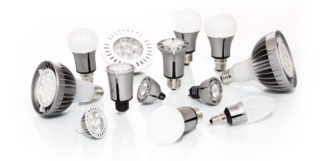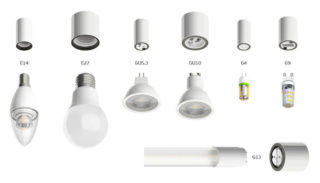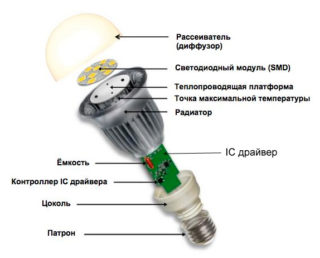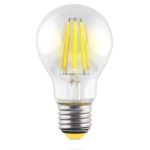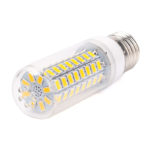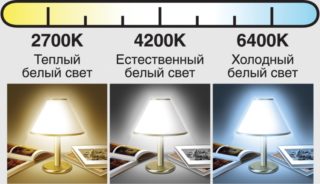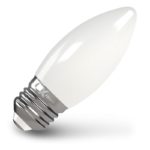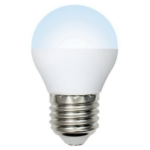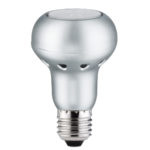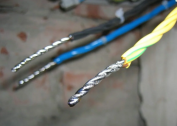LED lights are at the peak of popularity, rapidly displacing luminescent, halogen and spiral analogues from the interior. Mass production and improved technology has led to a significant reduction in product prices. Various types of LED lamps have become affordable and popular due to numerous positive technical characteristics. Products create a powerful light flux, which is characterized by a natural spectrum and the absence of flicker. The bulbs have a long service life, are not afraid of moisture and temperature changes. They are used not only for indoor, but also for outdoor lighting in the private sector and public places.
LED lamp classification
LED lights fall into two broad categories: for lighting and display (backlight). Lamps are used to illuminate rooms and territories, to highlight objects from the darkness that need attention. LED spotlights are used for the manufacture of panels, sensors and displays.
Further products are classified by scope:
- Personal goals. Creation of comfortable conditions in residential and auxiliary rooms, offices, salons and offices.
- Personal lighting. Table lamps, sconces, floor lamps, lanterns, portable lamps.
- Searchlights to highlight the territory, single and group objects.
- Agriculture. Special types of LED lamps stimulate photosynthesis.
- Trade. Production of signboards and showcases.
- Headlights for vehicles - cars, motorcycles, aircraft,
- Lighting for rooms where explosives are stored.
All types of products are environmentally friendly. When damaged, they do not emit harmful substances into the environment.
Varieties of cap
Depending on the application conditions and tasks performed, lamps of various sizes, brightness, power and configuration are used. To adapt new types of LED lamps to the standards of previously developed devices (chandeliers, sconces, point reflectors), manufacturers used the types of socle corresponding to them. Thanks to this, you can easily select the right product to replace a burned-out element or to carry out its modernization.
There are such types of socles for attaching sources to the cartridges of devices for various purposes:
- E14. It is used to equip small chandeliers in the kitchen, sconces and floor lamps, designed for a voltage of 220 V. Power is 3-4 watts with a minimum size. Thread - 14 mm.
- E27. They are used to complete devices that are designed to equip residential and office buildings, street lamps in pedestrian areas. The external diameter of the thread is 27 mm.
- E40. Such fasteners are used to attach large flasks used in spotlights and spotlights. The external diameter of the thread is 40 mm, with a power of up to 100 watts.
- GU10. The mount is a plug, the distance between which is 10 mm. Lamps are designed to replace halogen analogues. Work from a household network, spending up to 10 watts.
- GU5.3. Miniature sources that are built into a suspended and suspended ceiling as primary or secondary lighting. Lamps consume up to 0.5 watts.
- G13 They are made to replace the popular tubular products of the T8 model. With different lengths and diameters they consume 2-6 watts. Rotary plug with an internal distance of 13 mm.
Using different types of LED lights, you can create business, decorative and office lighting styles of the selected color and intensity.
A variety of LEDs used for lighting
Products have a complex device that affects their cost.Light sources consist of such elements:
- plastic cap designed for diffusing radiation;
- electronic board, which is responsible for managing the parameters of the components;
- crystals, which depending on the shape and size create a different glow;
- aluminum radiator for heat dissipation;
- air vents for cooling;
- base for connection to the cartridge.
In devices of various types, the following types of bulbs can be used:
- SMD They are miniature crystals that are soldered on a pre-prepared board. Used to create indicators, panels and ribbons. The base can be solid and flexible within the size of the crystals. The most popular models in this line are 5630 and 5730, measuring 3x5 mm and designed for continuous operation for 10 years.
- COB. They are complex devices having their own control chip and cooling radiator. In the manufacture of large crystals with high radiation intensity. Used in the production of jupiters and spotlights.
- Filament. They are an analogue of incandescent lamps, where instead of a spiral glass threads with conductors are installed.
- Filament
- COB
- SMD
To achieve the desired type of lighting, diodes are equipped with cases, reflectors and reflectors of a certain shape.
Light flow
 The emission of LED sources differs according to several criteria, depending on their design and other parameters. Glow power is measured in lumens and watts. Moreover, such a thing as power is measured in units of energy consumed, and lumens - in the amount of emitted photons. In addition, the brightness and efficiency of devices has an indicator in the number of lumens per watt.
The emission of LED sources differs according to several criteria, depending on their design and other parameters. Glow power is measured in lumens and watts. Moreover, such a thing as power is measured in units of energy consumed, and lumens - in the amount of emitted photons. In addition, the brightness and efficiency of devices has an indicator in the number of lumens per watt.
Product quality is determined by such indicators:
- low - 60-80 Lm / W;
- average - 100-125 Lm / W;
- high - 130-190 Lm / W.
The best European and American manufacturers have a ratio of 250 Lm / W.
The next criterion is the color temperature level, which determines the hue of the created color. It can range from dazzling white to bluish.
The classification of sources according to the color temperature level is as follows:
- Warm white - candle, dawn, sunset. Range - 1800-3900 K.
- Neutral - moon, day. Range - 4000-5400 K.
- Cold white - cloudy day, white night. Range - 5500-6900 K.
The efficiency of LED sources is much higher than all available analogues. To determine the power of the light flux, the equivalent of its correspondence to a conventional incandescent lamp is taken. Depending on the quality and level of color temperature of the product, the ratio is 1: 6-10.
Differences in housing design
The simplicity and reliability of the design of LED conductors allows you to give them a wide variety of shapes and sizes, including from existing analogues.
The following models of luminaires are on sale:
- A55 - standard pear-shaped with a base E27;
- C35 - conical even, angular or twisted with a socle E14;
- G45 - spherical with a socle E27;
- R39, R50 and R63 - reflex directed action with socles of all kinds.
- A55
- C35
- G45
- R39
- R50
- R63
The shape of the case is selected for shades, caps and reflectors. Decorative flasks can be used without diffusers.
Criterias of choice
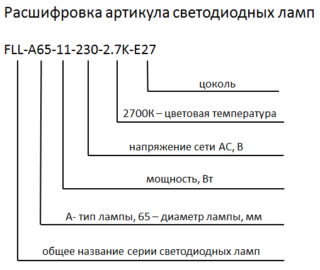 When choosing a product, you need to pay attention to the marking applied to it, and for this you need to know what it means.
When choosing a product, you need to pay attention to the marking applied to it, and for this you need to know what it means.
Example: E27-C-3900.
Decoding:
- E27 - spiral base 27 mm;
- C - conical body (candle);
- 3900 is a neutral color.
Attention should be paid to such features as product life and manufacturer's warranty. It depends on how long the product will last and the ability to exchange it.
When choosing a ceiling lamp, you should be guided by the following criteria:
- Colour.For the home, it is better to choose the range of 3500-4800 K. Dull and overly bright sources can cause visual impairment.
- Power. Diode lamps for a 12 volt house illuminate a small area. To create comfortable conditions in the room you need 1 lamp for every 2 m².
- Ripple level. The lower it is, the less eye strain.
Avoid buying cheap products. It is likely that this is smuggling without a license. It will shine badly, but will not last long.
For the first time, the ability of diodes to glow, emitting photons under the influence of current, was discovered in 1907 in England. In Russia, a patent for this invention was issued in 1927. Industrial production of products began in 1951 in the United States. LEDs were widely used at the beginning of the 21st century with the development of computer technology and their implementation in all areas of industry.
